This time of year, my family enjoys taking a weekend snowshoeing and cross-country skiing outing in the Idaho mountains to the north of our home. There is much to recommend this adventure: breathtaking scenery, great exercise and the peace of gliding amongst ponderosa pines at dusk.
However, wildlife sightings can be particularly hard to come by. With deep snow and frigid temperatures, the Rocky Mountains are not particularly hospitable in winter. Many species migrate to lower elevations or warmer climes. Others hibernate or become inactive. The species that do stick around are often difficult to spot.
A notable exception is the pileated woodpecker, one of our most frequently spotted species on these outings. Pileated woodpeckers are big, striking and entertaining to watch. With a range covering many habitats across the United States and Canada, you may be able to make your own observations near your home.
Pileated woodpeckers are notably elusive birds. Despite their size, in the spring I often only see their distinctive wing flaps as they fly away from me. In the winter, though, I’ve found that you can often get quite close and observe them undisturbed.
What you will notice first, of course, is their legendary wood pecking. Their large, strong bill serves as a powerful chisel on dead trees. The pileated woodpecker will eat a variety of foods, including seeds and a number of insects, but carpenter ants make up their primary diet. (The Cornell Lab of Ornithology reports that the diets of some studied pileated woodpeckers are made up of 98 percent carpenter ants).
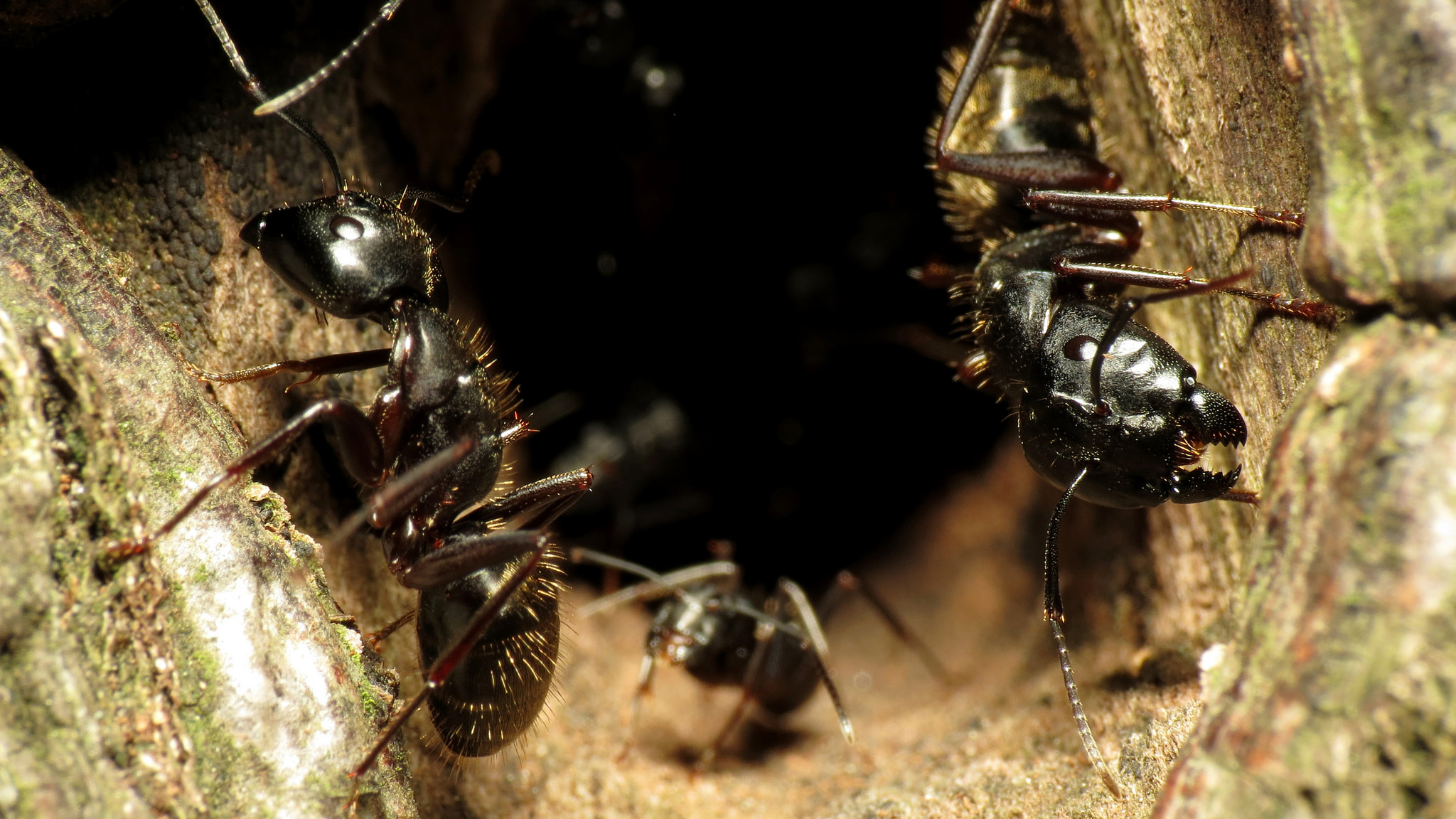
The woodpeckers go to great lengths to extract these ants. They pound out large, square holes in soft, dead wood. According to the Cornell, they use their barbed tongues to extract their prey from deep in the hole. Dead trees with abundant ant populations are foraged repeatedly by the woodpeckers. You can often see a tree full of holes from a distance (especially in winter) and piles of woodchips will pile up on the snow.
Stake out such a tree and you’re almost certain to see a pileated.
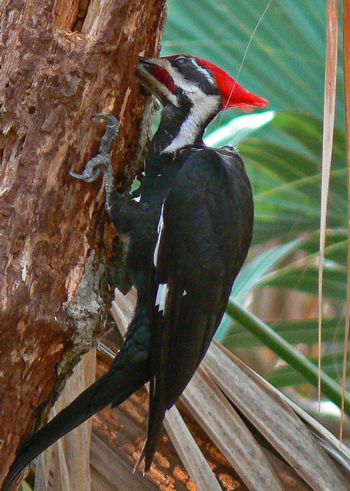
I love how deep snow muffles sound in the forest. But a woodpecker’s rat-tat-tatting still carries. The pileated woodpecker also has a very distinctive call, one that sounds like it would be more at home in a Hollywood movie set in the Amazon than in the local woodlot. In late winter (and other times of year), the male will often “drum” on a tree to mark territory.
Why are pileated woodpeckers so noticeable on a Rocky Mountain winter day? It’s quite simple: they don’t migrate. The species is highly territorial and a monogamous pair inhabits and defends a territory year round. When a member of the pair dies, a new woodpecker can move in and become mates with the surviving member.
The pair’s territory can be 150 to 200 acres. You may find, as I do, that you find pileated woodpeckers in basically the same spots each year. If a dead tree is still standing, you will probably find the same pair foraging there.
Ornithologist Joe Smith wrote previously on Cool Green Science how some bird species huddle together in large masses to stay warm on a cold winter’s night. (There is a report of more than 100 pygmy nuthatches piling into a hole in a dead pine tree on a particularly cold night). Pileated woodpeckers are the opposite: in the winter, each woodpecker excavates its own hole and roosts by itself. The male woodpecker often uses the same hole used for nesting; the young birds have already dispersed by winter.
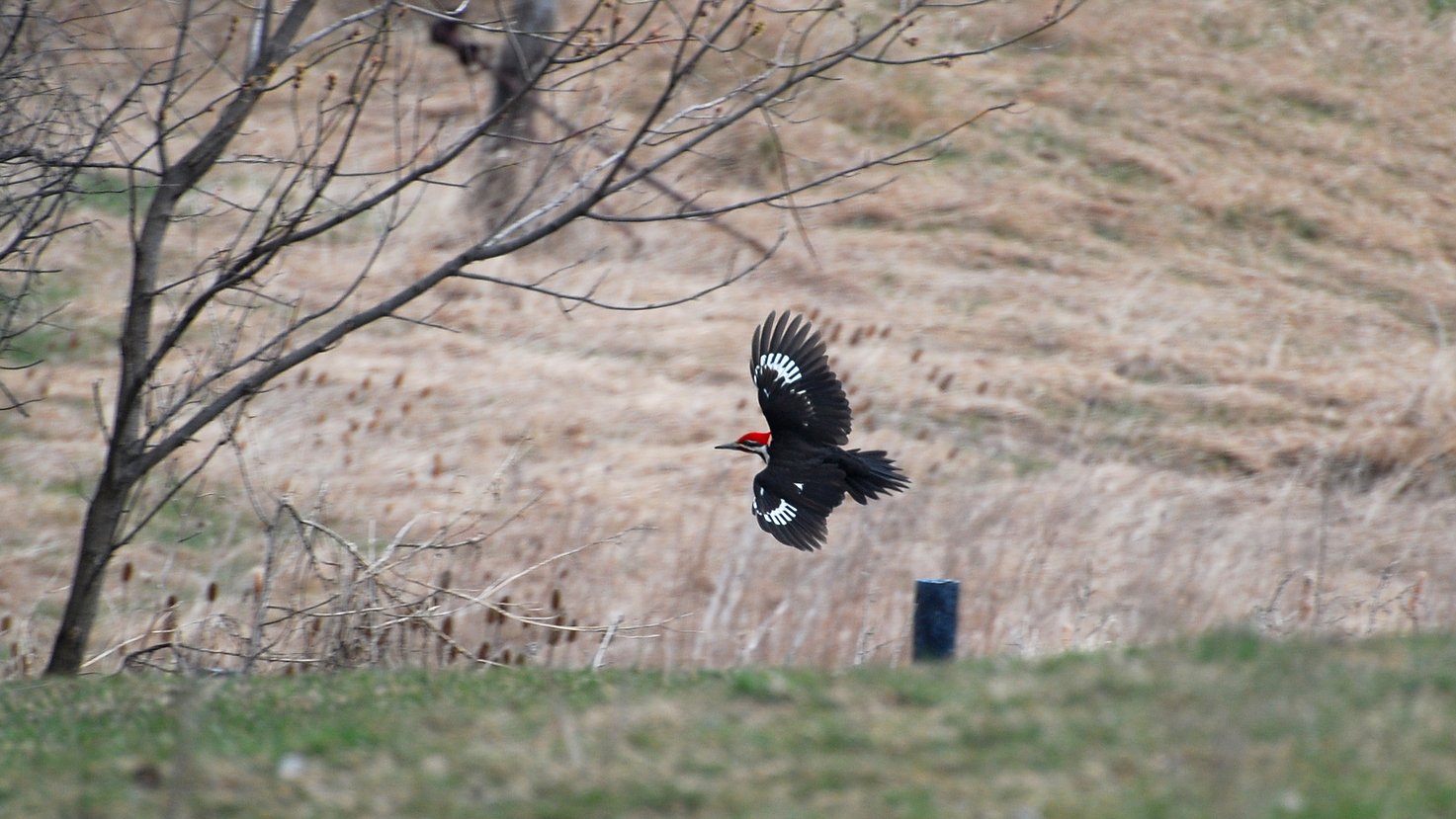
The pileated woodpecker is an important species in many different forest ecosystems. Their extensive holes become homes and shelter for a variety of species, from wood ducks to American martens. Their loud foraging attracts other birds to share in the bounty.
Pileated woodpeckers have actually increased in population since 1966, according to Cornell. The biggest thing we can do to ensure their continued prosperity is this: keep some dead trees in the forest.
Dead trees are sometimes considered unsightly or dangerous, but they’re vital to a variety of wildlife. Pileated woodpeckers forage on standing dead trees, fallen trees and stumps. Private landowners, preserve managers and timber companies can all leave a few dead trees for the birds.
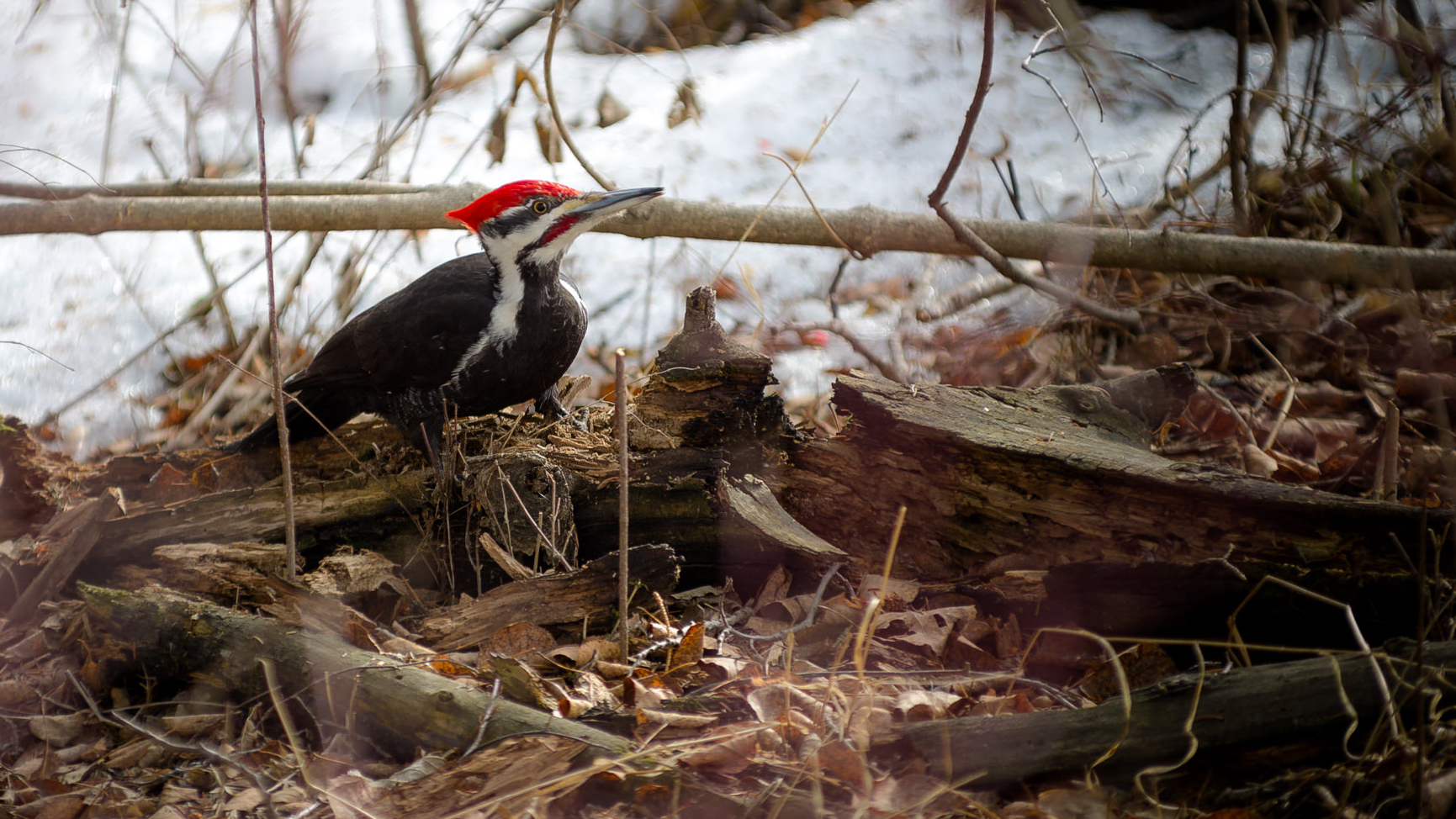
Dead trees were part of The Nature Conservancy’s forest conservation planning in North Idaho, and I saw these dead trees even on industrial timber land. And without fail, those trees would be pocked with holes from woodpeckers.
Pileated woodpeckers are found in a variety of forest habitats in North America, not just the ponderosa pine ecosystem of the Rockies. Get out there, listen and observe. The pileated woodpecker is elusive and spectacular, but the great news is it is still very common in forests and woodlots.
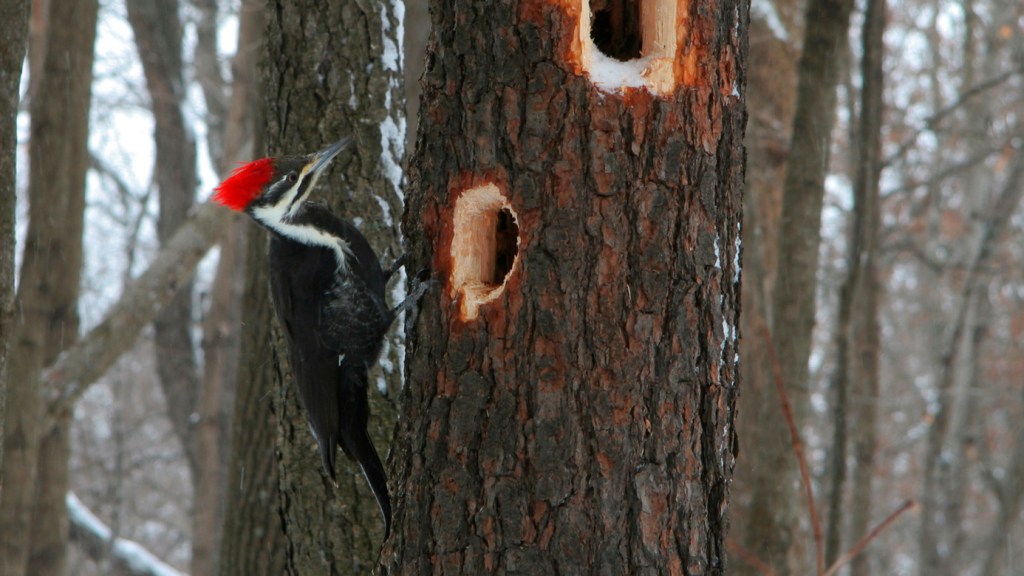



Thank you for the info 🙂
I have a pileated woodpecker that eats my sunflower seeds all day and then flies to a secret location at night! It’s about -55C right now in Alberta, I wish I could bring him in my house haha
the deck of my cabin at Truman lake is 10 feet off the ground on steep hill. we were about 12 feet from above him watching him chisel into a big limb. chunks were flying.
Beautiful pics. We live in Kalkaska county,Mi. Enjoy beauty of Pileated, drilling sound, and tolerate their low overhead flights, however frightening. Thanks for info, will be more observant this winter.
I seen a pleated woodpecker at my daughters house yesterday in Columbia to I have never seen on that size before
I have obsereved for several years that a female pileated woodpecker comes to my suet feeder from March through Mid May. During this time she comes abpit every two hours but never early morning or late evening. Mostly between 9 am and 5 pm. I have never seen her any other time of year. I know they don’t migrate so I’m wondering why this is the only time she comes. I have speculated that this may be the time she is raising a new brood of chicks. I live in northern Indiana among or near 200 year old oak and maple trees and only a block away from woods with large dead trees. Has anyone else observed this?
WE have one or more ( Piley) is his name (male) here in Farwestern MD Mt country! He is quite friendly on feeders. Flys in with a scream ( gets other birds to scatter) and if I am on the deck, he will play pick-ah-Boo behind close tree ( holds one end of closeline feeders). Will fly up close to me as I am getting out more fat for him. Also lots of dead stumps and trees with BUGS he feeds on. Have photos. However, NEVER seen him in cold winters ( today was 8F) in our 10 yrs at this lake house. Most birds stay as I feed the black seeds all winter ( especially under 32F temps) ! Dick in Swanton MD on Deep Creek Lake
We love the Pileated Woodpecker. Our favorite bird by far. We sometimes get a good look at one or two during the winter when they visit the suet feeder. Always a pleasure to see and hear them! We’ve taken some nice pictures of a pair.
I just seen one of these beautiful birds in my front yard this afternoon. I live right in the middle of a town so I was very surprised to see this big guy stop on by and check out my young maple tree. I feel like he was only resting and off he went to the neighbor across the streets house where he has some old dead looking like trees in his yard, he didn’t stay long but boy was he pretty.
I live in piedmont N.C. and see one every once in awhile but this yr I got to see both of them together for 1 st time. We have 3 different types of woodpeckers that hang out but the pileated is the most elusive one and it’s such a sight to see them. Wish I knew how to make them want to stay longer. But I will take what I can get and be happy to see them no matter how brief. I live in a pine thicket so they may be around more than I realize because I have seen them on other side of property also.
We have a pair that visit us. They are so much fun to watch. You can hear them coming way before you see them. They are our favorite birds. They look so prehistoric. Amazing creatures!
I spent many hours in the woods in northern Indiana to get a photo of the pair making their territory known. I first saw one in flight early January 2019. Later, I noticed the trees with the signature holes. After many hours and patience, I finally got some pictures!
We were visited recently by a Pileated Woodpecker in our back yard in suburban Palm Beach County, Florida. We have seen one three times since 1996 in close by areas. He stayed about 45 minutes this time.
In your blog you mention pileated’s roost by themselves. I’ve had an active nest cavity the last several years behind my house in Lodi, Wisconsin and have watched them roost in the winter in that cavity. Last night the male was at the tree pecking a bit, the female came flying over and entered the cavity and the male followed her into the cavity right at dark. I suspect this pair roosts together often during the cold winter months of Wisconsin.
Could you please tell me what kind of nest this is. I live in Chattanooga, TN. This nest was built on the side of a dead tree. It looks like it’s made from paper almost like a dirt dauber’s nest. It has two sections with small holes spaced in the nest. Dec. 09, 2018.
Thank you.
I have a neighbor who has a tree stump that she believes is definitely being chomped by pileated woodpeckers, but she has tried all times of day to catch a glimpse of him (or her) ‘in the act’ — to no avail. Any suggestions? ) I’ve mentioned listening out for his sounds, but she does not seem to hear them from inside.